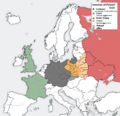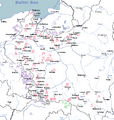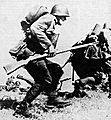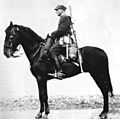Invasion of Poland (1939) facts for kids
Quick facts for kids Invasion of Poland (1939) |
|||||||||
|---|---|---|---|---|---|---|---|---|---|
| Part of World War II | |||||||||
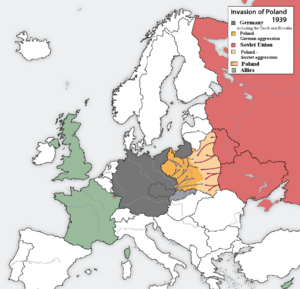 The map shows the beginning of the Second World War in September 1939 in a wider European context. |
|||||||||
|
|||||||||
| Belligerents | |||||||||
|
|
|||||||||
| Commanders and leaders | |||||||||
|
(Ukrainian Front) |
|||||||||
| Strength | |||||||||
|
Germany: Total: 1,500,000 Germans, 466,516 Soviets, 51,306 Slovaks Grand total: 2,000,000+ |
Poland: 39 divisions (some of them were never fully mobilized and concentrated), 16 brigades, 4,300 guns, 880 tanks, 400 aircraft Total: 950,000 |
||||||||
| Casualties and losses | |||||||||
|
Germany: USSR: 1,475 killed or missing, 2,383 wounded |
Poland: 66,000 dead, 133,700 wounded, 694,000 captured |
||||||||
The Invasion of Poland in 1939 was a major military attack. Nazi Germany, and later the Soviet Union, invaded Poland. This event marked the start of World War II in Europe. The invasion lasted from September 1 to October 6, 1939.
After Germany invaded, Britain and France declared war on Germany on September 3. However, they did not offer much help to Poland during this time. In the end, Poland was defeated. Germany and the Soviet Union divided Poland between them, as they had secretly agreed to do before the war began.
Contents
The Blitzkrieg Attack
This invasion is often seen as the first time "blitzkrieg" was used. Blitzkrieg means "lightning war" in German. It was a new way of fighting that involved fast, surprise attacks. It used many tanks and airplanes to quickly break through enemy lines.
The German surprise attack worked very well. Poland's army was not fully ready for war. They had fewer tanks and airplanes, and many were old. The Polish forces were surrounded and outnumbered. This made it easy for the blitzkrieg to defeat them. If Poland had been fully prepared, they could have had two million soldiers ready to fight.
Early Battles and Polish Resistance
In the first few days, the Polish army fought harder than the Germans expected. At the Battle of Mokra on September 2, Polish forces pushed back a German tank division. This forced the Germans to retreat.
The German air force also faced resistance from the Polish Air Force. Even though the Polish planes were outnumbered, they fought bravely. However, because Germany had so many more planes, they gained control of the sky after about five or six days.
Fighting for Poland's Freedom
Poland was surrounded by German territory to the north, west, and south. This left little room for the Polish army to retreat. German troops reached Warsaw, the capital, and attacked on September 7. But the Poles fought back, causing heavy losses to German tanks. The Germans had to pull back.
The Battle of the Bzura on September 9 was the largest attack by the Polish army during the invasion. The Poles had great success at first. They badly damaged two German divisions and captured 3,500 German soldiers. Polish foot soldiers fought very well. But by September 19, strong German reinforcements defeated them.
Continuing the Fight Abroad
The Polish leaders realized that Britain and France were not going to help Poland directly. This period was later called the "Phoney War" because there was little fighting on the Western Front. Then, on September 17, the Soviet army invaded Poland from the east.
Because of this, the Polish high command ordered many troops and equipment to move towards Romania. Their goal was to get to France and continue fighting there. Most of the Polish navy managed to escape to Britain. Polish code-breakers, who had figured out the German Enigma (machine) code, went to France and later to Britain to keep working.
Polish politicians also set up a government-in-exile (a government operating from another country) first in France, then in Britain. By 1945, when the Allied armies invaded Germany, the Polish army was the fourth largest Allied army. They played a big part in the final victory.
Images for kids
-
Vyacheslav Molotov signs the Molotov–Ribbentrop Pact, a German–Soviet non-aggression pact.
-
German troops during the fighting in the streets of Warsaw
-
Disposition of all troops following the Soviet invasion.
-
Hitler attends a Wehrmacht victory parade in Warsaw on 5 October 1939
-
Polish uhlan with anti-tank rifle (Wz. 35), 1938
See also
 In Spanish: Invasión alemana de Polonia de 1939 para niños
In Spanish: Invasión alemana de Polonia de 1939 para niños



